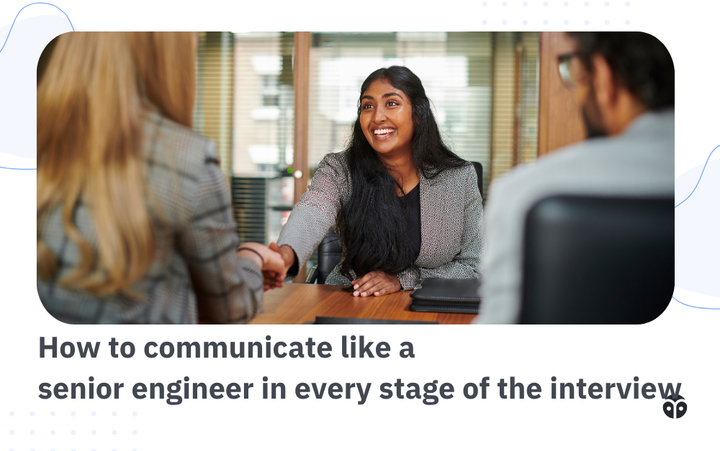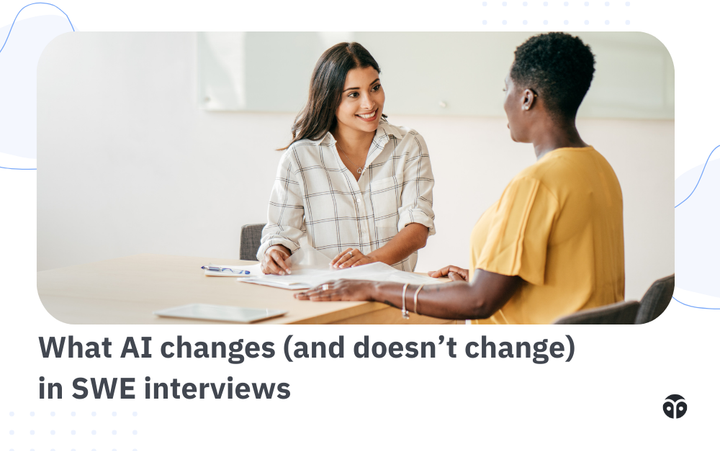How to write a great cover letter
A cover letter template for SWEs on the job hunt.

If your resume is a documentation of your professional history, your cover letter is your chance to share your story, explain the “why” behind your career moves, and stand out from other applicants.
Whether explaining an employment gap, pivoting into engineering, or expressing your passion for a specific company, a thoughtfully written cover letter can be the key to catching a hiring manager's eye.
Here’s how to craft a cover letter that grabs attention, adds depth to your resume, and leaves a memorable impact.
Why write a cover letter?
Writing a cover letter can set you apart in a competitive job market by providing a personalized touch that your resume alone can’t convey. Writing a cover letter doesn't guarantee success 100% of the time, but when it does work, it can make all the difference. That alone makes it worth the effort.
While skipping a cover letter might not always disqualify you, it’s a missed opportunity to strengthen your application and make a memorable impression.
If you choose not to include a cover letter, you risk
- Missing a chance to stand out. Without a cover letter, you lose the chance to highlight your personality, motivation, and enthusiasm for the role—factors that can differentiate you from other candidates with similar qualifications.
- Bring misunderstood. A cover letter provides context for your resume, explaining career transitions, employment gaps, or specific experiences that may not be immediately clear. Without it, hiring managers might make assumptions or overlook critical details.
- Being seen as not serious. Some employers see a cover letter as a test of how interested and dedicated you are to the role. Not submitting one may signal a lack of interest or effort, which could reduce your chances of moving forward in the hiring process.
- Your resume being tossed out. Some job postings specifically request a cover letter. In those cases, failing to include one could result in your application being discarded automatically, which may signal a failure to follow instructions.
How to write a cover letter
A cover letter doesn’t need to be long, but each section serves an important purpose.
First paragraph: Capture attention and state your purpose
Your opening paragraph sets the tone, so it’s critical to make it engaging. Start with a strong, attention-grabbing sentence. This could be an interesting fact about your experience, a specific achievement, or something that connects you to the company.
- Example: "As a fullstack developer who recently optimized API performance by 275% for a fast-growing startup, I’m excited to bring my expertise to [Company Name].”
After your opening, clearly state why you're applying for the role and mention the job title. If you’re responding to a specific job posting, hyperlink the position title to make it easier for the recruiter to connect your cover letter to your application.
- Example: "I’m applying for the Fullstack Developer position at [Company Name], and I believe my experience in scaling backend systems would be a great fit for your team."
This paragraph should also briefly establish your professional identity and why you're interested in this specific role or company.
Middle: Showcase your value
The second paragraph is your opportunity to showcase your skills and experience in a way that aligns with the job description. Here, you should focus on a few specific highlights from your career that demonstrate your value. These highlights should match the job's key requirements and responsibilities.
- Example: "At [Current Company], I recently led a project to overhaul our payments API, increasing its capacity to handle 15,000 requests per second, up from 4,000 RPS. This required coordinating across multiple teams and ensuring zero downtime during deployment."
This is also a great place to address any unique aspects of your background that might not be obvious from your resume, such as a career transition, a gap, or a reason for your enthusiasm about the company’s mission.
- Example: "Before transitioning into software engineering, I worked as a product manager, gaining deep insight into understanding customer pain points and translating them into technical requirements. This experience allows me to build user-centered solutions and collaborate effectively with cross-functional teams."
You can also highlight soft skills like leadership, collaboration, or problem-solving if they are relevant to the role, and explain how they have made you successful in your career.
Final paragraph: Provide a strong closing and a call to action
The closing paragraph should reinforce your interest in the role and include a call to action. This is your chance to convey your enthusiasm for the company and the impact you hope to make. It’s also where you can give the recruiter an easy way to move forward with you in the hiring process.
- Example: "I’m excited about the opportunity to contribute to [Company Name], where your mission of [Company’s mission] deeply resonates with me. I would love to discuss how my skills and experience can add value to your team."
End with availability for an interview or initial call and thank the reader for their time and consideration.
- Example: "I’m available for an initial call this coming week and look forward to discussing next steps. Thank you for your time and consideration."
Remember, the structure provided is a guideline. If you have a creative approach or are writing for a dream company, don't be afraid to personalize it. A custom cover letter can be worth the extra effort when it's for an opportunity you're truly passionate about.
Cover letter template
Here’s a simple, effective template you can tailor for each job application:
Hello [Contact Name | Recruiting Team],
I’m a [type] software engineer applying for the [Role Name with hyperlink to Role URL] position at [Company Name].
As a [type] developer with [X years of experience, I’ve successfully [brief impactful achievement related to the job posting]. Currently, at [current company], I’m [specific achievement or project that demonstrates your skills in action]. This has allowed me to [explain how the achievement added value, aligned with the job you're applying for].
I’m particularly excited about [Company Name] because [specific reason you align with the company’s mission, values, or team]. I’m eager to learn more about the [team name] and contribute my skills to support your [specific goals or mission].
I’m available for an initial call during [Time Window 1] or [Time Window 2]. Thank you for considering my application, and I look forward to the opportunity to connect.
Thank you,
[Your Name]
Let’s look at how this template comes to life with real details:
Hello John,
I’m a Fullstack software engineer applying for the Software Engineer (Messenger Platform) position at Meta.
As a Fullstack developer with three years of experience, I recently led an initiative at Blastly that optimized our payments API, increasing its capacity to handle 15,000 requests per second (up from 4,000 RPS). This project required significant coordination across multiple teams, ensuring zero downtime during deployment. My ability to drive complex, cross-team projects makes me confident in my ability to contribute effectively to the Messenger Platform team.
I’m particularly excited about Meta’s mission to bring the world closer together. The impact that Messenger has had in connecting people globally is something I deeply admire, and I’d be proud to contribute to this important work.
I’m available for an initial call this upcoming Tuesday (3p-6p PT) or Thursday (9a-11a PT). Thank you for considering my application, and I look forward to discussing how I can contribute to the Messenger Platform team.
Looking forward to next steps,
Michelle
Do’s and Don’ts of Writing a Cover Letter
Do’s:
- Be specific to the company: Customize the cover letter by inserting details like the company’s name, mission, and relevant team. You don’t need to write a brand-new letter for every application, but small tweaks can go a long way.
- Start strong: Your opening sentence must grab attention. If it doesn’t, your letter may not get a second look.
- End strong: Your last sentence should make them want to reach out. After a powerful introduction, ensure your closing is equally compelling with a clear call to action.
- Keep it short: Hiring managers typically spend less than 30 seconds on a cover letter. Limit your cover letter to 3 concise paragraphs.
- Send it as a PDF: Always submit your cover letter as a PDF unless otherwise specified. It’s the most professional and universally accepted format.
Don’ts:
- Avoid typos or formatting issues: Spelling mistakes or awkward spacing are immediate dealbreakers. Proofread carefully before hitting send.
- Don’t overemphasize bootcamp experience: If you’ve attended a bootcamp, mention your coding experience, but avoid making it the main focus.
Need more? Get holistic interview prep with Formation
The Formation Fellowship gives mid-level and senior engineering job seekers everything they need to land their dream roles—including personalized skill brush-ups, resume help, unlimited mock interviews with experienced software engineers and hiring managers from top-tier tech companies, career and negotiation support, and more.
If you’re having trouble navigating your job search on your own, apply here and get unconditional support from a team of engineering mentors, technical recruiters, career coaches, and more.



